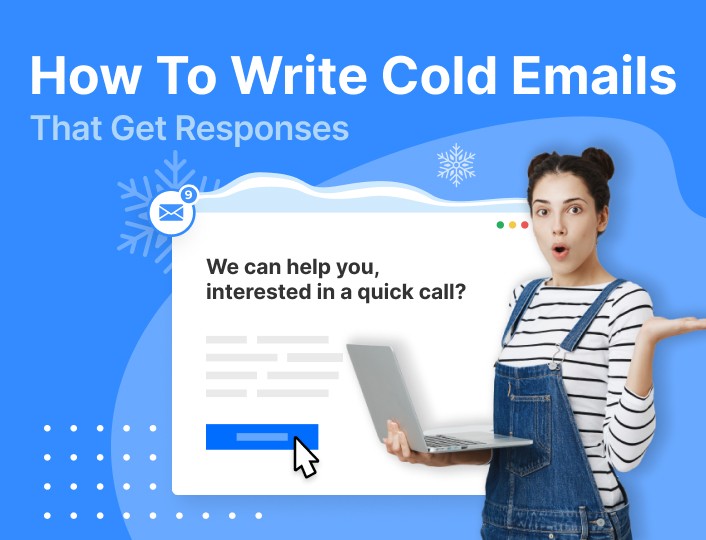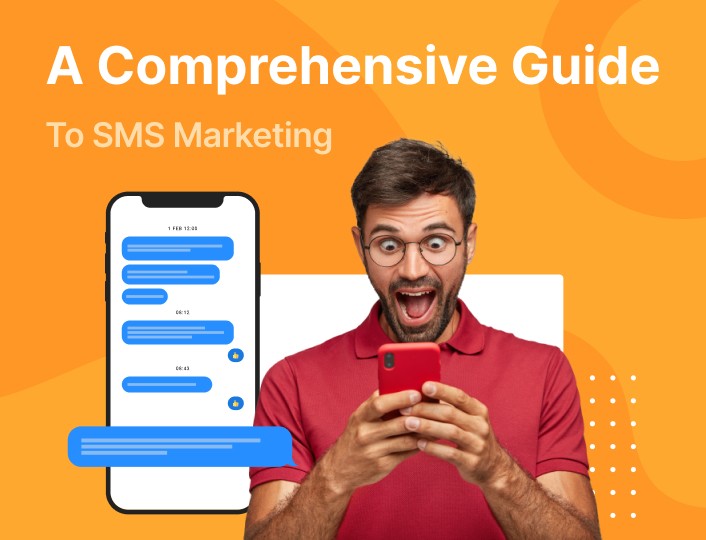Have you tasted the frustration that comes with writing cold emails that never get responses? Maybe you even did everything you know to do but haven’t seen any improvement. It’s time to learn how to write cold emails that are stellar and get responses all the time.
But first, a short intro into the world of cold emailing…
What is Cold Email Marketing?
Cold emailing is a form of email marketing you use to achieve business goals like acquiring leads, promoting your product, etc.
It is a way of communicating via emails with specific individuals. With cold email marketing, the objective is to hold a business conversation with a prospect, as you can see below.
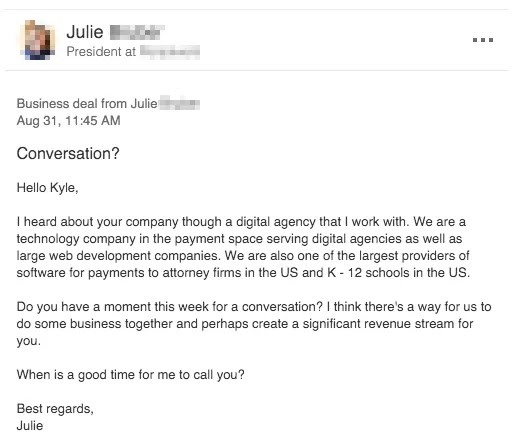
The reason they are called cold emails is because they are sent to individuals you haven’t made contact with, and without their permission. This means that the sender and recipient usually do not have any relationship before the email.
This kind of email is intended for business-related interactions and should not be intrusive.
Cold emails are not the same as spam emails. Cold emails, unlike spam emails, are tailored to be directly helpful to the individuals or businesses that receive them. Look at it this way; cold emails are personalized and relevant to the recipient while spam emails are not, and thus hardly relevant to the receiver. .
How do you know that your cold email outreach is successful? When you have generated enough interest from your prospects to elicit a response that will kick off what will hopefully birth a successful business relationship. Simply put, your cold email is successful when you get an outcome that favors your business.
How Best Is Cold Email Marketing Used?
You can use cold email marketing for a number of things. Its applications are not limited to just trying to sell products and services. For that, you need creative email templates. One of the experienced writers who provide write my essay for me or email template writing service can help you in this. Below are 4 main ways you can use cold marketing in your business:
1. To Build Relationships
An excellent way to get cold marketing to work for you is by using it to build a business relationship with your prospect. You can do this by first sending an introductory email.
With an introductory email, you get to tell your prospective client what you do and why you think they will benefit from what you have to offer. As a business marketer or owner who aims to sell your business, you can build a lasting relationship with this marketing strategy.
An introductory cold email should have:
- Your name,
- The name of your company,
- The services you provide,
- How they are beneficial to your prospect as an individual or company.
Here’s a template you might want to use:
Hi (prospect’s name),
My name is (your name). I head the marketing department at (your company name). We recently developed a product that (what it does).
I believe it can (mention a unique benefit of your product).
Would you be open to a call on (time and date) to discuss further how our product can help your business (mention a related general benefit)? If not, let me know the next best time, and I’ll be happy to accommodate.
Thanks for your time.
Best regards,
(Your Name).
With this, you’ll be setting the foundation for not just a sale but a business relationship.
2. For Lead Generation
When it comes to marketing, a lead is a person or company interested in your product or services.
So, it follows that lead generation is the process of searching for people, or prospects, that might eventually become paying clients. It also involves contacting them to start a business relationship and, in the end, convert them to customers.
The main aim of lead generation is to fill up your sales funnel. There are several ways to generate leads, but cold emailing is also worth trying.
One other reason that cold emailing is well worth it is that it costs next to nothing. You don’t have to pay for an email marketing service – just your Gmail account will do.
What’s more, cold emails also prompt a direct reply from your prospects. In our opinion, this is a natural and effective way to generate quality leads for your business.
3. Find Talents and Forge Partnerships
Whether you are looking for the best talent that are fit for your company or pitching your business to potential partners, cold emailing is your best option.
This way, you can tell them the specific value they get by working with you or for you, as the case may be.
4. Invitation
Cold emails are not just for selling products or services. If you own a blog, podcast or are even holding a webinar and you wish to let more people know about what you do, this marketing strategy is best for you.
In essence, you can increase traffic and webinar attendance by sending cold emails to people and corporate bodies who are likely to be interested in your niche.
How To Write Cold Emails Effectively
Cold emails are a touchy subject. Most people shy away from them.
The most common reason is the fear of getting ignored. And trust me, you will most likely get ignored.
But do you know that cold emails can give you the best marketing results when used correctly?
However, to be successful at it and prevent your time from being wasted, you need to know the art of writing cold emails. One wrong move, and your email may end up in the annoying spam folder.
To help you create cold emails that will break the ice (pun unintended) between you and your prospects, we have laid down some constructive tips for you.
Of course, these tips are not set in stone, as there are no laid down rules for writing the perfect cold email. But trying out different strategies will cut it for you.
If you have a formula that already works for you, that’s fine. But it wouldn’t hurt to add the tips I will be sharing here.
The goal? To help you fully explore the true potentials of cold emailing.
1. Define Your Goals
The first step to creating a successful cold email outreach is identifying and articulating your goal. Your goal could vary from building a network around your brand to finding a business partner to work with.
As an individual or a team of marketers, it is essential that you state what you want to achieve, understand it, and, if you can, write it down. This way, you can structure your cold email campaign and regroup when necessary.
2. Pick Out Your Prospects Carefully
The first step to writing cold emails that get responses is knowing your prospects. Do your due diligence to ensure that the services you provide will be helpful to them.
There is no point pitching a product meant for a remote worker to a nine-to-fiver, for example. What to do? Filter your entire mailing list and narrow down your target audience until you feel like you know them personally.
Choose your prospects carefully, not at random. You should be familiar with your prospects- know what they do, their position in the company you wish to work with if necessary, etc. This will help you increase your chances of getting responses to your cold emails.
3. Introduce Yourself
Don’t be a shadow. Your prospects will feel a lot better if they know who you are and why you contacted them.
The first shot you will have at introducing yourself is in your email’s first line. Let this line give your prospects important information about you and your company at first glance.
This is your first impression on the prospect and it will go a long way in helping you create and maintain a relationship.
It is usual for your prospects to have an initial wariness- albeit slight- about a strange email in their inbox. Your introductory line will give you a chance to gain their trust and put them at ease- just enough to get them to read your email further.
What should you include in your email’s first line?
Your first name. Or maybe last. Perhaps both. Your company name will also do. Just whatever that is interesting enough to grab their attention right out of the box.
Want a bonus trick that works? Before sending out your cold email, put it away for a bit if you can. When you get back to it, put yourself in your prospects’ shoes and reread your email, but this time with a fresh outlook. How impressed do you think they will be at first glance?
4. Keep Your Subject Line Interesting
Another element of your cold email that will tell your prospects the very first thing they need to know about you is your title/subject line. You must keep your subject line professional yet interesting and catchy.
Personalizing your subject lines also increases your chances of getting your cold emails opened. Simply adding your prospect’s name to your subject line can increase your cold email open rates by about 20%. Trust me, you don’t want to miss out on that number.
Your subject line should give your prospect an idea about what the body of your email contains. A well-written subject should pique a prospect’s interest as soon as they see it. If your subject line isn’t catchy enough, it might end in the trash bin. Or remain forever unopened.
So, consider what subject line will sound promising to your prospect. Of course, writing the perfect one might take a few trials and edits, but in the end, it is worth it.
5. Keep It Short and Simple
No one wants to read an email that is too lengthy, especially when it is from a stranger – or a spambot.
Thus, when writing a cold email, you want to keep it short, simple, and easy to digest. As a rule of thumb, don’t try to sell your products and services from the start. Your goal should be to first lay the foundation for a relationship.
Need I mention that the focus of your email should be about them, and not you? Nobody is really interested in knowing how awesome you are, but what value you are bringing to them.
Additionally, show your prospects why you think they should work with you. Try not to use a lot of words. Get right to how you can be of help to them. Remember, the goal is not to hard-sell. Instead, it is to set up a lasting business relationship.
6. Personalize Your Messages
Personalizing your emails like you know your prospects personally is a great way to impress them. Talk to them like you are talking to someone you’ve been friends with for years. Do not be vague or too formal.
Tell them what they do and tie it back to why you think they can benefit from your company.
You don’t have to state everything about them in your email. You may come across as a stalker, which would be bad for business. So, you only want to mention what is relevant to the value you’re offering in your email.
7. Review Your Email Before Sending Out
Apart from ensuring that you are sending your cold emails to the right people, you must review them thoroughly. A misspelled word, for example, won’t look good to your prospect.
Ensure that your cold email is free of errors. Proofread thoroughly and make corrections where necessary. Ensure that your email introduces you, what you do and how you can help your prospect.
Most times, the human brain unintentionally skips errors. This is why it might be a good idea to use spell-checkers like Grammarly and ask for help from your team, friends, or family.
8. Send Follow-Up Emails
Sometimes, your prospects might need a little push and convincing to get them started. Remember to keep in touch with them via follow-up emails.
Your initial cold email might warm them up, but subsequent cold emails might just be the deal setters. So, be consistent but not overly pushy.
Overall, there are no known universal formulas to help you create the perfect cold email outreach. Simply work with these tips and align them with what you think is best for your brand.
Cold Email Examples
So that you know what a typical cold email looks like, we’ve collected 5 examples to illustrate what we’ve discussed so far. Feel free to take a cue or two from them for your next cold email.
1. A Cold Email Draft from My Archives
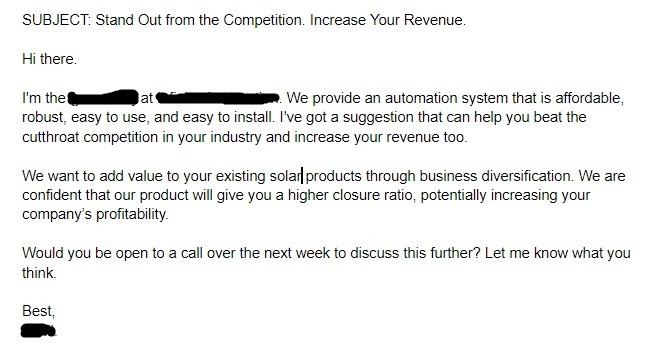
This cold email is relatively straightforward and checks a lot of boxes. First, it introduces the sender, the product and immediately mentions how it will help the prospect.
When writing your cold emails, it’s important to keep the focus on your product’s benefits and not features. This is the best way to keep your prospect engaged.
Also, the sender exudes confidence in the value of their product through this email. Thus, the prospect is more likely to read further.
After elaborating a bit more on the benefit of their solution to the prospect, they immediately follow it up with a phone meeting request. What better way to end this cold email?
2. The Familiarity Approach
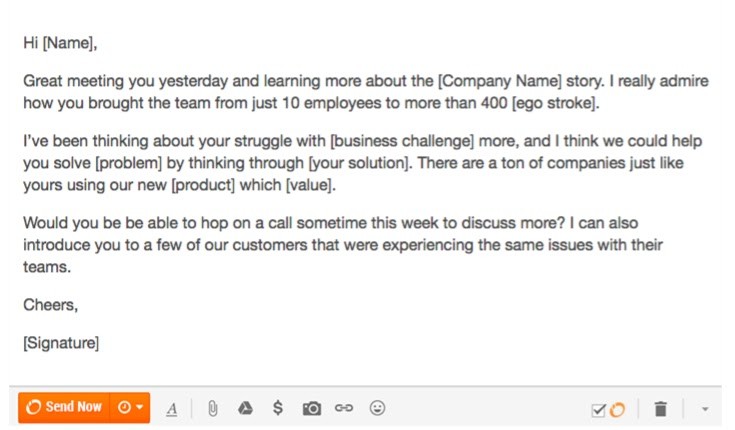
Although this is more of a template than an example of an actual cold email, we’ll show you one or two ideas you can use as cues. From the beginning, the sender strikes a chord of familiarity with the prospect’s work.
They then immediately mention the prospect’s pain point, thereby further engaging them. The sender follows this up with a statement that implies that their product didn’t just get off the shelf. So, if you can prove the value of your product, by all means, do so.
The email is then wrapped up with a call-to-action. Make sure to always ask your prospect for a response at the end of your emails. It increases your chances of actually getting a response.
3. Get Familiar with Your Prospect’s Product
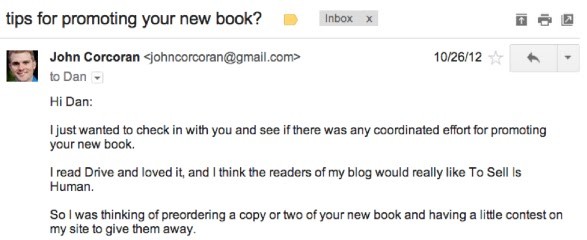
Here, the sender doesn’t just offer to promote the prospect’s book; he has also read it. It’s wise to get familiar with your prospect’s business as much as you can. It’ll help you tailor your solution specifically to them.
This doesn’t just apply to books. If you’re an influencer looking to partner with a brand, this is a great approach to take. Get familiar with the product you are interested in promoting and speak directly to it in your cold email.
4. Football Leagues and Tech?
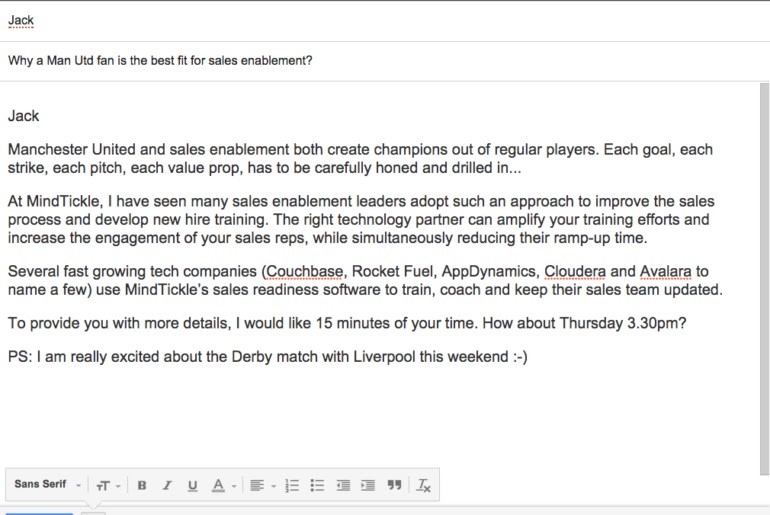
Wondering how football and a tech solution are related? This sender has taken time to research their prospect- down to their favorite football league.
With this mundane piece of information, he has crafted an outstanding and highly personalized cold email.
This cold email can’t but get a response. Don’t you agree?
You may not know your prospect’s favorite football league, but I’ll bet you can learn something about them that helps pique their interest.
5. Spotlight on Pain Point

This is quite an audacious cold email. The sender elaborates on the prospect’s pain point and doesn’t mince words.
They back their statements up with statistics that show that they have done their research.
Good thing the email ends with a solution for the prospect. At this point, the prospect probably can’t wait to respond anyway.
5 Best Tools For Cold Email Marketing
Sending cold emails out to prospects can be a daunting task. This is why cold email marketing software exists to make the whole process easier. Here are some of the best ones to help you with your cold email marketing campaigns:
1. GMass

Looking for a cold email marketing software that you can use to send out emails in large quantities? GMass can help you do just that.
It makes cold emailing easy with Gmail. It’s like having a cold email service directly within your Gmail account.
GMass makes it possible to send out cold emails that help increase your chances of getting your desired responses. It also allows you to personalize your cold emails with its collection of cold email templates.
It also offers a scheduled automation feature and helps you track open rates of the emails you send out.
Want to get GMass? Its standard pricing starts at $12.95 per month.
2. Woodpecker
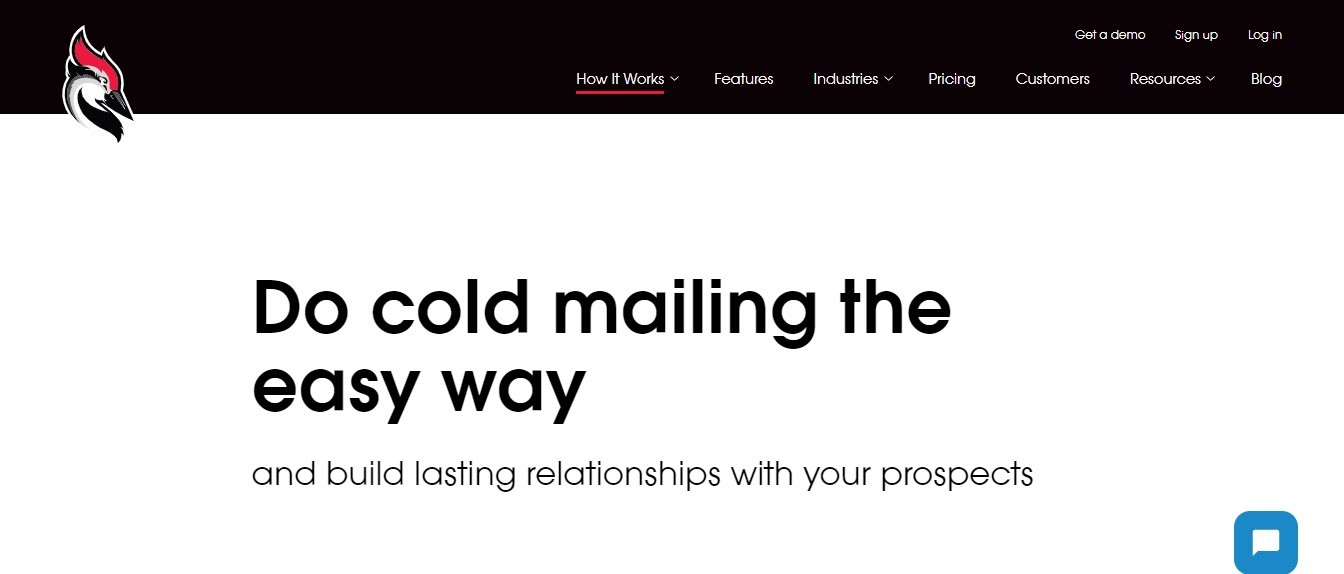
Woodpecker is another cold email marketing software tool that allows you to send out cold emails from Gmail and Microsoft Outlook. It is used chiefly by B2B companies to personalize, automate, and track their sales campaigns.
Woodpecker comes with a collection of cold email templates that you can personalize the way you want. Plus, it provides features that allow you to customize and preview your cold emails before sending them out.
Woodpecker offers flexible plans, with the cheapest one being $39.
3. Lemlist

Looking for a cold emailing software that doesn’t require a credit card to get started? Lemlist is your answer. With Lemlist, your cold emailing campaign will become seamless.
What’s more, if you need features for personalizing your cold emails, automate follow-up emails, and engage with your leads across all channels, Lemlist is the choice for you.
Brands like Sumo and Comet trust Lemlist, and it integrates seamlessly with email solutions like Google, Office365, and Exchange. It also serves as a sales engagement platform.
These features are available at pocket-friendly prices, with the cheapest being $29.
4. Yesware
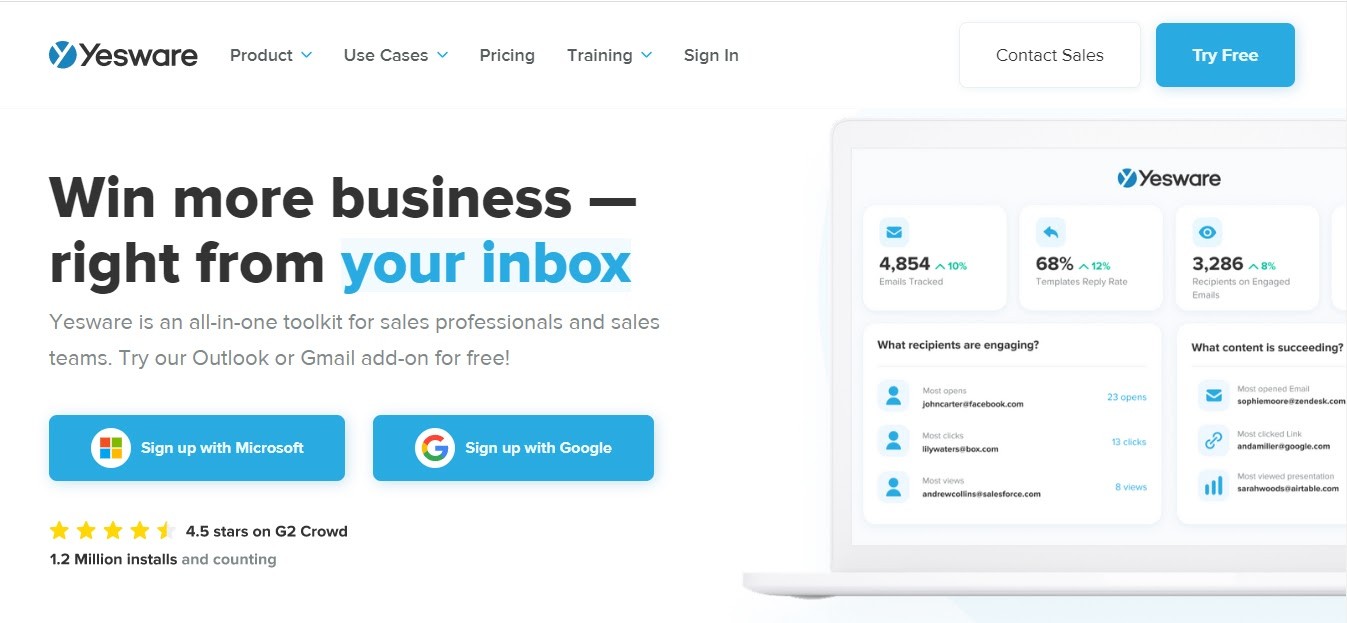
Yesware is a sales productivity tool that comes with everything you need to send cold emails with ease. It has features like email tracking, attachment tracking, multi-channel campaigns, meeting scheduler, cold email templates, and many more.
It is trusted by Autodesk and Groupon and has impressive features that allow you to connect to your prospects on a personal level.
Yesware offers a free trial option and a subscription plan for as low as $15 per month.
5. Streak
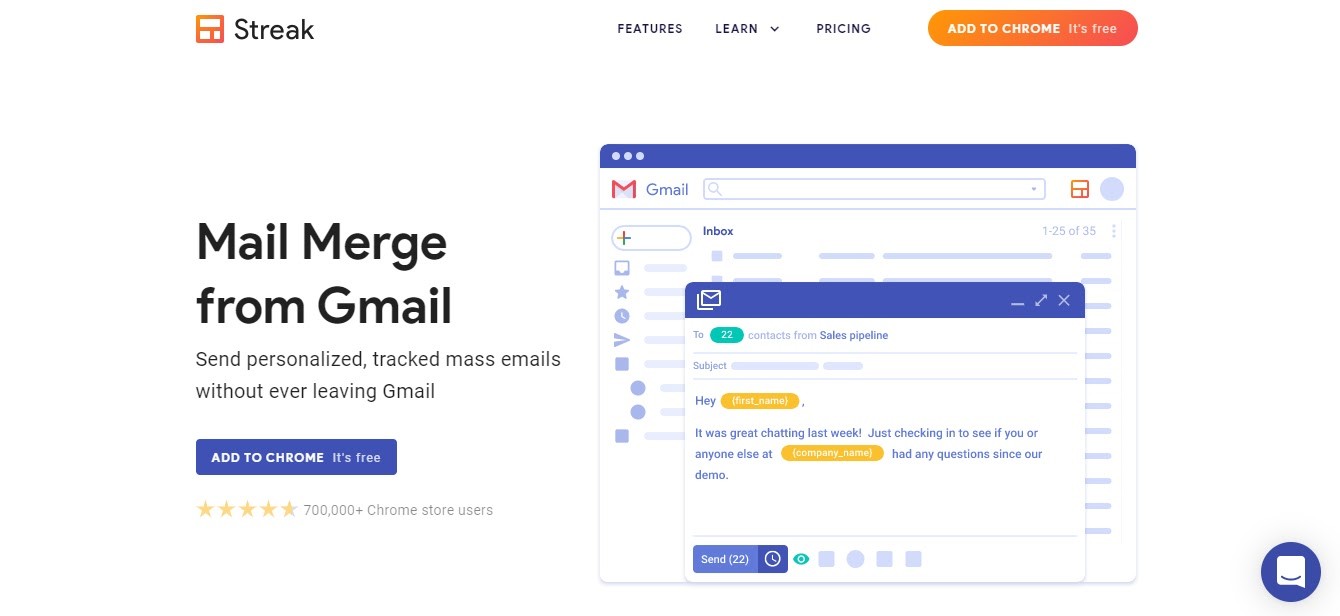
Streak is an email tracking software that gives you useful analytics on cold emails you send to your prospects.
It shows you when and how many times your email was viewed. This way, you don’t have to be in the dark concerning the status of your cold mail after it gets into your prospect’s inbox.
Streak provides you with charts and a host of other functions that will be helpful in your cold email campaigns. It is easy to use and provides you with real-time data.
Conclusion
I hope you enjoyed reading this as much as I enjoyed putting this together for you. Now that I have armed you with all you need to know about cold emails and how to create them, get to work creating yours right away.
Before you do that, don’t forget to share this post. You’ll definitely be helping someone. One last thing: sign up on Adoric to get access to tools that will make all the difference your business needs. It’s free, so don’t hesitate!

